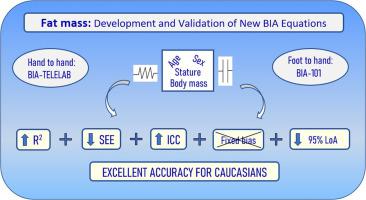当前位置:
X-MOL 学术
›
Nutr. Res.
›
论文详情
Our official English website, www.x-mol.net, welcomes your feedback! (Note: you will need to create a separate account there.)
Development and validation of new bioelectrical impedance equations to accurately estimate fat mass percentage in a heterogeneous Caucasian population
Nutrition Research ( IF 4.5 ) Pub Date : 2024-01-10 , DOI: 10.1016/j.nutres.2024.01.002 Daniel Rojano-Ortega , Heliodoro Moya-Amaya , Antonio Jesús Berral-Aguilar , Paolo Baratto , Antonio Molina-López , Francisco José Berral-de la Rosa
Nutrition Research ( IF 4.5 ) Pub Date : 2024-01-10 , DOI: 10.1016/j.nutres.2024.01.002 Daniel Rojano-Ortega , Heliodoro Moya-Amaya , Antonio Jesús Berral-Aguilar , Paolo Baratto , Antonio Molina-López , Francisco José Berral-de la Rosa

|
Fat mass percentage (%FM) is frequently determined by nutritionists and personal trainers with bioelectrical impedance analysis (BIA) devices. The aims of the present study were: (1) to develop new regression equations using dual-energy X-ray absorptiometry (DXA) as the reference method for estimating %FM in a heterogeneous Caucasian population with a foot-to-hand device (BIA-101) and a hand-to-hand device (BIA-TELELAB) and (2) to compare the new equations with the manufacturers’ equations. We hypothesized that the new equations would lead to more accurate estimations compared with DXA. A total of 218 healthy Caucasian participants aged 18 to 65 years were divided into a development group and a validation group. The accuracy of the different equations was assessed by mean differences, coefficient of determination, standard error of the estimate (SEE), intraclass correlation coefficients (ICC), and Bland–Altman plots. The proposed equation for BIA-101 explained 90.0% of the variance in the DXA-derived %FM, with a low random error (SEE = 2.98%), excellent agreement (ICC = 0.94), no fixed bias, and relatively low individual variability (5.86%). For BIA-TELELAB, the proposed equation explained 88.0% of the variance in the DXA-derived %FM, with a low random error (SEE = 3.27%), excellent agreement (ICC = 0.93), no fixed bias, and relatively low individual variability (6.37%). The results obtained for the manufacturers’ equations confirm that these equations are not a good option for %FM assessment. As hypothesized, the new regression equations for BIA-101 and BIA-TELELAB devices can accurately estimate %FM in a heterogeneous Caucasian population with a broad age range.
中文翻译:

开发和验证新的生物电阻抗方程,以准确估计异质白种人群体中的脂肪质量百分比
脂肪质量百分比 (%FM) 通常由营养师和私人教练使用生物电阻抗分析 (BIA) 设备来确定。本研究的目的是:(1) 使用双能 X 射线吸收测定法 (DXA) 开发新的回归方程,作为使用脚手装置 (BIA) 估计异质白人人群中 %FM 的参考方法。 -101)和手动设备(BIA-TELELAB)和(2)将新方程与制造商的方程进行比较。我们假设与 DXA 相比,新方程将带来更准确的估计。共有 218 名年龄在 18 岁至 65 岁之间的健康白人参与者被分为开发组和验证组。不同方程的准确性通过平均差、确定系数、估计标准误差 (SEE)、组内相关系数 (ICC) 和 Bland-Altman 图进行评估。 BIA-101 的拟议方程解释了 DXA 衍生的 %FM 中 90.0% 的方差,具有较低的随机误差 (SEE = 2.98%)、出色的一致性 (ICC = 0.94)、无固定偏差和相对较低的个体变异性(5.86%)。对于 BIA-TELELAB,所提出的方程解释了 DXA 导出的 %FM 中 88.0% 的方差,具有较低的随机误差 (SEE = 3.27%)、出色的一致性 (ICC = 0.93)、无固定偏差和相对较低的个体偏差变异性(6.37%)。制造商方程获得的结果证实这些方程不是 %FM 评估的良好选择。正如假设的那样,BIA-101 和 BIA-TELELAB 设备的新回归方程可以准确估计年龄范围广泛的异质白种人群体中的 %FM。
更新日期:2024-01-10
中文翻译:

开发和验证新的生物电阻抗方程,以准确估计异质白种人群体中的脂肪质量百分比
脂肪质量百分比 (%FM) 通常由营养师和私人教练使用生物电阻抗分析 (BIA) 设备来确定。本研究的目的是:(1) 使用双能 X 射线吸收测定法 (DXA) 开发新的回归方程,作为使用脚手装置 (BIA) 估计异质白人人群中 %FM 的参考方法。 -101)和手动设备(BIA-TELELAB)和(2)将新方程与制造商的方程进行比较。我们假设与 DXA 相比,新方程将带来更准确的估计。共有 218 名年龄在 18 岁至 65 岁之间的健康白人参与者被分为开发组和验证组。不同方程的准确性通过平均差、确定系数、估计标准误差 (SEE)、组内相关系数 (ICC) 和 Bland-Altman 图进行评估。 BIA-101 的拟议方程解释了 DXA 衍生的 %FM 中 90.0% 的方差,具有较低的随机误差 (SEE = 2.98%)、出色的一致性 (ICC = 0.94)、无固定偏差和相对较低的个体变异性(5.86%)。对于 BIA-TELELAB,所提出的方程解释了 DXA 导出的 %FM 中 88.0% 的方差,具有较低的随机误差 (SEE = 3.27%)、出色的一致性 (ICC = 0.93)、无固定偏差和相对较低的个体偏差变异性(6.37%)。制造商方程获得的结果证实这些方程不是 %FM 评估的良好选择。正如假设的那样,BIA-101 和 BIA-TELELAB 设备的新回归方程可以准确估计年龄范围广泛的异质白种人群体中的 %FM。



























 京公网安备 11010802027423号
京公网安备 11010802027423号